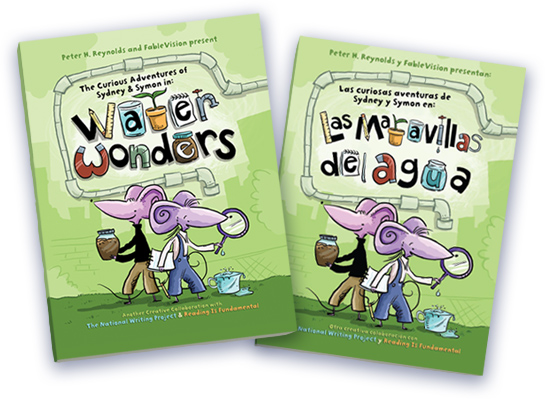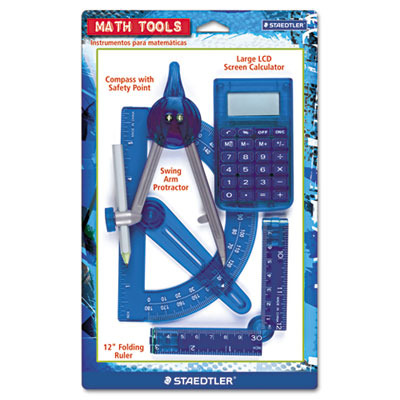 by Caryn M. Boehm,
Communications Strategist
Learn more about Caryn here.
by Caryn M. Boehm,
Communications Strategist
Learn more about Caryn here.
FableVision, with Reading Is Fundamental and The National Writing Project, recently launched the book The Curious Adventures of Sydney and Symon in Water Wonders—an early reader chapter book starring sibling mice Sydney and Symon. In Water Wonders the dynamic duo explore science and engineering concepts while using writing, art, and even song to express and celebrate their ideas and discoveries.
Water Wonders was created to champion the concept of adding Arts to STEM education (Science, Technology, Engineering, Math), turning it into STEAM. Adding the arts is a way to invite learners into intimidating subject areas, and Water Wonders does this beautifully with smart and fun characters, a great story, and hands-on activities. While planning last month’s book release party at our Boston studio and putting together materials for the tomorrow's discussion panel on Capitol Hill (click here for more information!), I have come to realize that adding Arts to STEM is definitely a hot topic. From Grateful Dead drummer Mickey Hart to the National Science Teachers Association, you’ll find advocates for the STEAM approach in every corner.
This got me thinking about my experiences with these subjects, and I thought I’d share some thoughts on my personal educational journey. I have a feeling there are plenty of people whose journeys took similar turns.
When I think about my childhood, I know that I am one of the lucky ones. I had a great, fun, supportive, silly family. We traveled. We played games together. We built things together. My answer to “What do you want to be when you grow up?” included everything from astronomer and marine biologist (what little girl doesn’t, at some point, want to spend her life playing with dolphins?) to veterinarian, nurse, and occupational therapist. It is interesting to look at this list of science-focused occupations, and then look at the BFA in Theatre from Boston University that now hangs on my wall. How did I go from curious, science-loving elementary student to a college student whose joy in participating in a conservatory theatre program came partly from the lack of science or math requirements?
My early childhood education was a mix of public schools, schools on Air Force bases, and, for two years, a tiny Catholic school with scary nuns and compulsory Thursday morning Mass, providing me with quite a broad range of perspectives. My earliest memories of science classes involve experiments with taste buds, writing and illustrating my own book about how the heart works, and decorating the pages of my leaf collection. In third grade, I was one of three students who always had an answer during science lessons, and we dubbed ourselves “The Science Triangle.” My dad had a subscription to Astronomy Magazine, and I would pore over the amazing images between learning about basic biology from my own subscriptions to Animal Fact Files and Zoobooks. I loved art as a kid, of course, but I also LOVED science. Art was fun; science was THRILLING!
So what happened to steer me away from science? Where did everything change? There’s no question: it was between 8th grade and 10th grade. Although I still enjoyed my science classes at the start of high school (mostly biology focused; I got to dissect a fetal pig in 9th grade!), there was another subject that became my nemesis, my mortal enemy, my raison d’hatred (this is a phrase I have just invented): Math. Confusing, inflexible, you’re-right-or-you’re-wrong math. I was a straight-A student until I encountered advanced math. I viewed math classes as a chore: my own personal hell where, for the first time, I just didn’t get it. Numbers on a board, formulas to memorize, problems straight from the book, calculators and protractors…none of this was fun for me.
My lack of confidence in math turned into a lack of interest in doing well in the math-heavy science classes: Chemistry and Physics. In 9th grade, Biology was one of my favorite classes. In 10th grade my Chemistry teacher was so dry, he put himself to sleep during lectures, and the calculations and lab work made me nervous and anxious. In 11th grade Physics, even the more creative experiments intimidated me because there was such a connection to math (I’m ashamed to admit to the amount of help I got from my dear ol’ dad with the Build-A-Bridge-Out-of-Toothpicks project…I built model airplanes and rockets as a kid, but I couldn’t make a bridge with confidence anymore! After all of my failures in math class, the fear of failing was too much for me). By senior year, it was French and Drama Club that got me out of bed in the morning (just barely, I was a teenager, after all); science was no longer my “thing.”
I sincerely miss the passion I once had for science, and the feeling that I could someday have a future in it—changing the world and changing lives with amazing discoveries. Some days, while we watch the Science Channel, I’ll mention to my boyfriend how I sometimes wish I could’ve studied something science-related in college. His response, of course, is always, “You could’ve. You can. Go back to school. You are smart!” This makes me turn to my usual excuse: “But I can’t do math,” and his usual counter: “You just had bad teachers.”
Although I wasn’t particularly fond of my math teachers in high school, I can’t really blame them. They were teaching the subject the only way they knew how. From the book, by the book. Boy, did I hate those books! How would my life be different now if my schools used the STEAM approach, incorporating the arts and creative thinking into science and math learning? I can only imagine! Clearly, I have an affinity for the arts; I went to school for theatre and I now work for FableVision, one of the most wonderfully creative companies around. I am excited to see the new developments in education that are happening, and am so proud to be a part of FableVision’s mission (and so grateful that being part of the FV family has encouraged my artistic side—I will make my mark and not take my imagination for granted ever again!). Let’s all join FableVision and NWP and RIF and all the other amazing education innovators out there; let’s all become champions for initiatives like STEAM. The U.S. is falling behind in education, there is no doubt about it. Maybe it is too late for me, but someday I may have kids of my own who face the same challenges I did with STEM subjects, and I hope my kids and your kids and our grandkids and their grandkids will not lose that confidence like I did.
Check out this fantastic animation adapted from a speech given by Sir Ken Robinson, world-renowned education and creativity expert:
For the full 55-minute version of the talk (when you have the time to spare, it is definitely worth it!), CLICK HERE.
Additional links you might like:
The Creativity Crisis: Why American Schools Need Design - The Atlantic
STEM to STREAM: Writing as and Essential Part of Science Education




